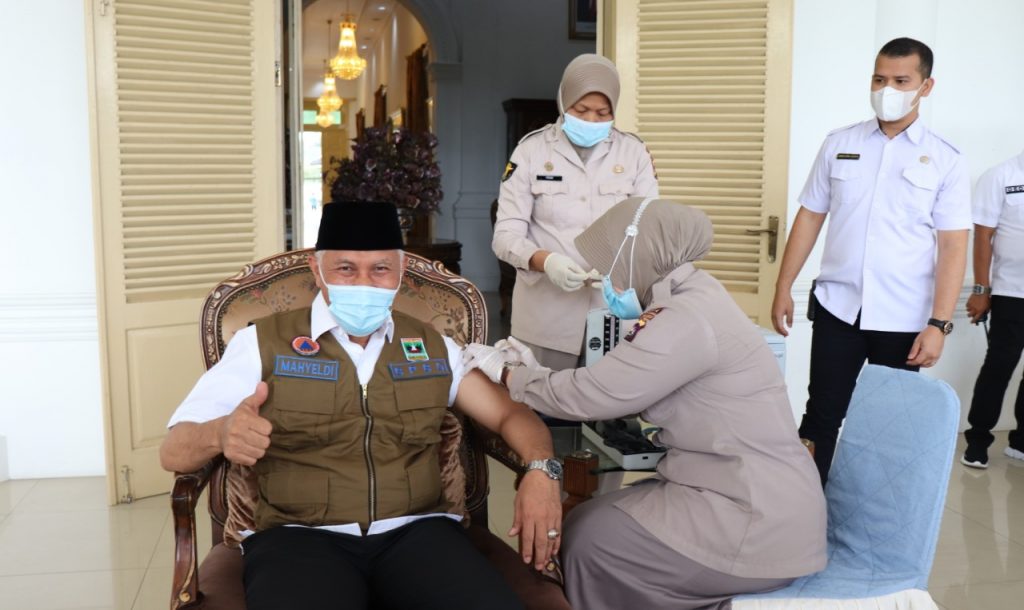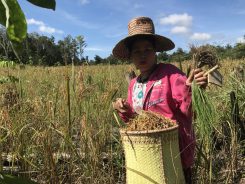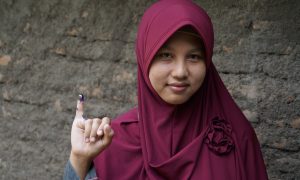Local government and civil society responses to the Covid-19 pandemic in Indonesia have been widely lauded in academic and popular media since the first Covid-19 case was confirmed in March 2020. Indeed local mitigation and healthcare responses have proven critical in the face of central government failures in many aspects of pandemic responses. What early studies have not shown however, has been the role that women have played in leading these local responses. My new study uncovered a disjuncture between men’s high representation in formal Covid-19 leadership and decision-making bodies, and women’s overwhelming domination of the daily work of pandemic leadership in both infectious disease mitigation and healthcare responses. While I focused on just one city in Central Java, we can assume that this division is mirrored in other parts of Indonesia and, indeed, in many parts of the world.
The results of research published in my new report sheds light on why women are minimally represented in official Covid-19 taskforce structures while having overwhelming majority representation in the frontlines of emergency and long-term pandemic responses. In January and February 2021 I conducted fieldwork with a masters scholar in the city of Salatiga, Central Java, collecting data on women public servants’ leadership roles in pandemic responses. In this report I extend on previous research on pandemic responses at local level by applying a gender lens to examine why women healthcare workers and officials, who have limited roles and responsibilities on formal Covid-19 taskforces at the city-wide and subdistrict level, have played the critical roles in leading mitigation strategies at both levels.
Click on the cover image below to download the full policy brief.
Failure of Covid-19 pandemic taskforces at local level
While national government regulations state that gender mainstreaming policies must be integrated into emergency and disaster response plans at the national and sub-national levels, women comprise only 7% of the national Covid-19 taskforce and 12% of, for example, the Central Java provincial taskforce. In the municipality of Salatiga in Central Java, gender representation in government is higher than the national average, however women still occupy a minority of positions in the highest echelons of the local government public service. This disparity had direct implications for the composition of Salatiga’s COVID pandemic taskforce where positions in it were allocated on the basis of structural positions within government without specific reference to gender. In the Salatiga city taskforce appointed in October 2020, women’s participation was 17% in a body of 12 members. The heads of strategic government departments, such as the heads of the regional police (Polres), the local military command base (Korem), the municipal police (Satpol PP), the Regional Planning, Research and Development Agency (Bappeda) and the National Unity and Political Department amongst others (Kesbangpol), are all headed by men and were automatically appointed to the taskforce. Despite violating gender mainstreaming principles, this local picture is typical of the situation across Indonesia both in elected government and amongst career public servants, with men holding a majority of higher echelon positions.
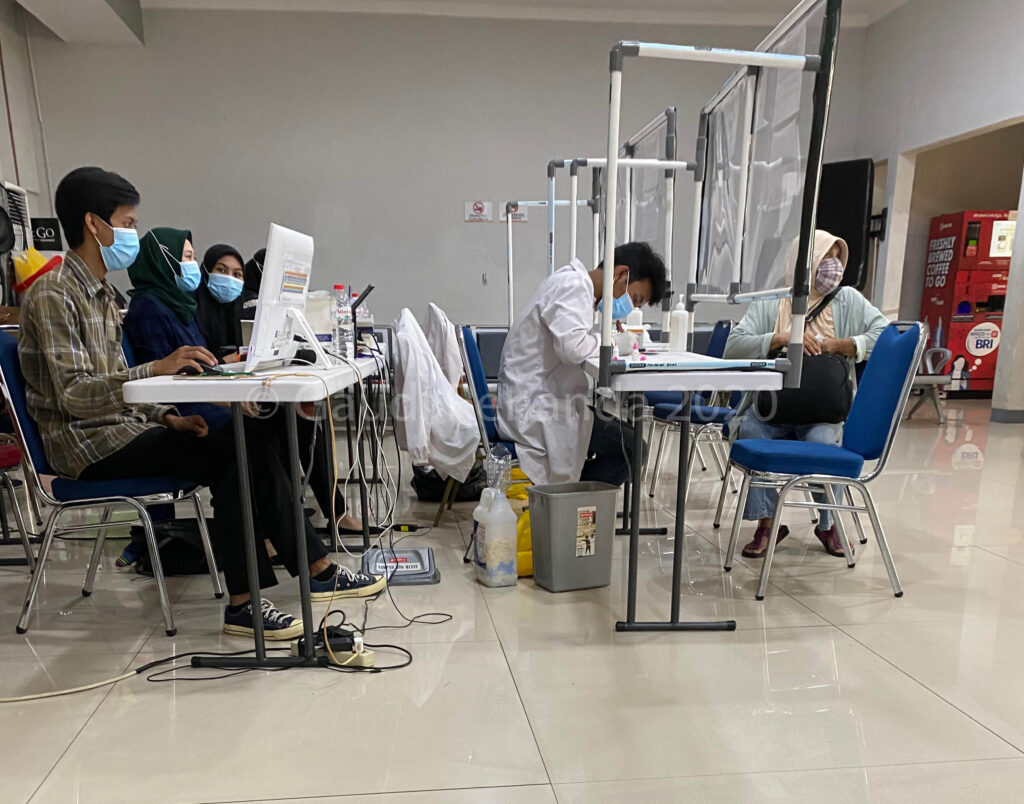
Rapid Test facility at Pasar Senen Station. Image credit: Gaudi Renanda in Wikimedia Commons (CC BY 4.0)
The Salatiga municipal taskforce is responsible for strategic pandemic mitigation policy and planning, cross-agency coordination, monitoring and enforcement of mitigation measures, budgeting and other resource allocations. Despite the assumed leading role of this male-dominated body, in practice it has been women that have principally led mitigation and healthcare responses, stepping up to fill gaps in formal leadership of pandemic mitigation measures.
Women’s leadership in the pandemic
In contrast to the city-wide COVID-19 taskforce, the Salatiga health department has a far higher proportion of women both in leadership roles as well as comprising the majority of healthcare workers. Overall women comprise 80% of the city’s health department workforce. At the community level, Salatiga’s healthcare response to COVID-19 was even more female-dominated. The directors of the city’s six community health centres (PUSKESMAS) are all women, with women comprising up to 90% of the health centres’ workforce.
In practice, pandemic responses not only in healthcare, but also in the critical area of infectious disease mitigation, were largely led by women from the health department, women staff of community health centres, and some acute care staff in the district and other local hospitals. The main weakness in pandemic responses identified by all those interviewed was the failure of the city-wide taskforce to provide leadership and direction. A health department official said that while government agencies have specific taskforce responsibilities in practice they run to the health department to find solutions. Women leaders working in healthcare at citywide and sub-district level argued that the citywide taskforce should be strengthened, to effectively monitor and evaluate the implementation of policies in the field, to supervise effective public communications including mitigation policies to the public, so that health services could prioritise deepening their knowledge of COVID-19 related health science and pandemic handling which is very dynamic and fast-developing.
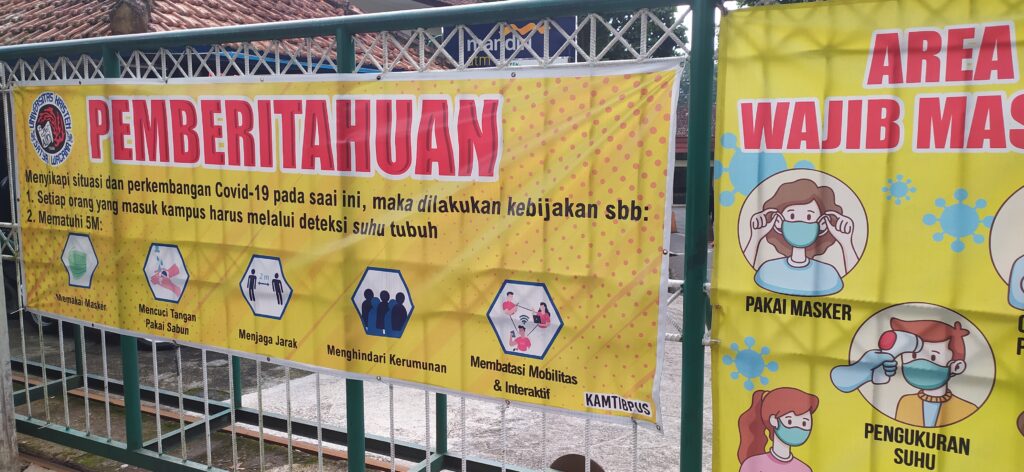
Banners communicate strategies for mitigiating COVID-19 spread. Image credit: Rebecca Meckelburg.
The report shows that there were four institutions that were critical in frontline health care—the health department, community health centres, the district hospital and a special isolation facility; while the first two of these institutions were also critical in mitigation responses. Indeed community health centres (puskesmas) have been the backbone of Salatiga’s pandemic healthcare and disease mitigation strategy as the frontline for testing, tracing and supporting people infected with COVID-19.
The strategic response of the health centre examined here was innovative, rapidly reorganising health centre workers into dedicated teams that manage COVID-19 patient work specifically and the remainder who continue to manage and provide general health services. At the community level, the community health centre head initiated cross-sectoral communication with sub-district stakeholders (with subdistrict government, police, military and local ward officials) and coordinated cooperation with community stakeholders, civil associations, religious groups and subdistrict government agencies.
Women’s pandemic workloads
National pandemic policy failures in Indonesia and many other countries have increased women healthcare workers’ paid and unpaid work burden. Much of the labour of women healthcare workers is not even visible let alone important in public policy– either in terms of the costs it imposes on a highly feminized workforce and society more generally, or the benefits it provides in terms of care work and social reproduction. The result is that the pandemic produced more complex work practices with higher workloads for women working at the frontline of the response, without additional human resources, while these women also had to deal more intensively with everything related to the pandemic in their domestic roles.
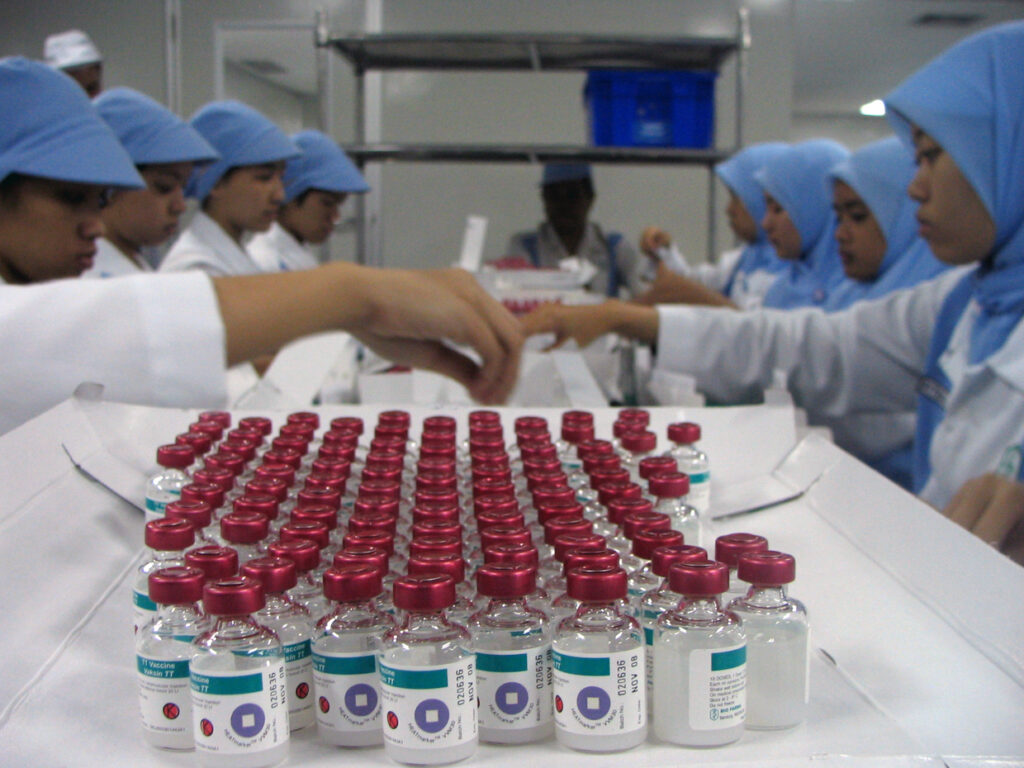
Lab workers in the Bandung BioFarma facility in Indonesia examine vials that have vaccine vial monitor technology incorporated into their labels. BioFarma, Bandung, Indonesia. Image credit: Ümit Kartoğlu for VOA on Wikimedia Commons
Most concerning is that these women hold significant knowledge through experience of managing this pandemic crisis. They know the shape of the COVID-19 pandemic and understand what practices work best—and what does not work—in mitigating the crisis. Yet their limited inclusion in formal structures with decision-making authority, continue to restrict women’s power to critique and shape political decision-making about priorities in COVID-19 pandemic responses.
COVID-19, food insecurity and the resilience of indigenous women in Indonesia
Protecting rural indigenous people’s control over food resources is linked to the wellbeing of migrant workers in the cities.
What women contribute to pandemic leadership
Scholars and advocates have argued for women’s participation in the design, implementation and monitoring of COVID-19 related laws and policies at all levels of government decision-making. My study shows that this participation is indeed necessary, not only to address the specific needs of women and girls in the pandemic, but, further, in order to draw upon the growing knowledge and experience of these women in developing timely pandemic strategies.
Healthcare managers and frontline workers identified several areas that required serious and immediate action. First, there needs to be better coordination, leadership and implementation of official duties in the city-wide taskforce. Second, improved monitoring and enforcement of health protocols in workplaces, public spaces and approved events including weddings, public ceremonies and venues that facilitated public gatherings are required. Third, there must be monitoring and enforcement of movement restrictions and local regulations on work from home quotas, limits on numbers in restaurants, hotels and other venues and home isolation. Fourth, there needs to be more extensive trace and test capacity by expanding physical facilities to support expanded testing as the lynch pin of sound epidemiological monitoring of disease prevalence. This epidemiological monitoring would support the development of a road map to successful disease suppression.
Local health departments and community health centres in Indonesia, run largely by women, have been a critical piece of infrastructure for Indonesia’s pandemic response. Both health department officials and health centre workers’ intensive community engagements have generated greater understanding of what COVID-19 is in local communities, driven coordination of cross-sectoral stakeholders where possible, provided active support for positive patients, and reduced community stigmatisation. Sadly, this critical role, as well as the knowledge and experience gained by these women, has not been acknowledged formally nor drawn upon as a critical resource in longer term pandemic planning and leadership. Ultimately, this failure to include these leaders undermines the capacity to provide well-coordinated wholistic responses to the COVID-19 pandemic at the local level, resulting in ongoing high levels of virus transmission and effectively extending the timeframe of the multiple crises resulting from the pandemic.
 Facebook
Facebook  Twitter
Twitter  Soundcloud
Soundcloud  Youtube
Youtube  Rss
Rss 